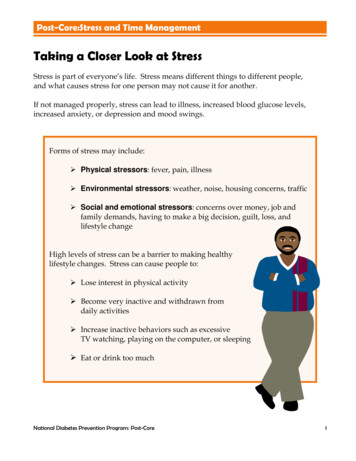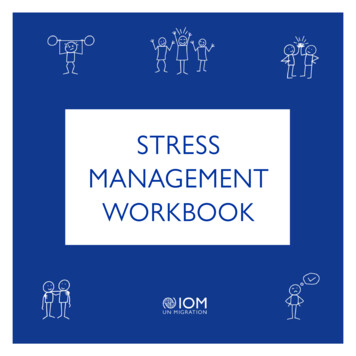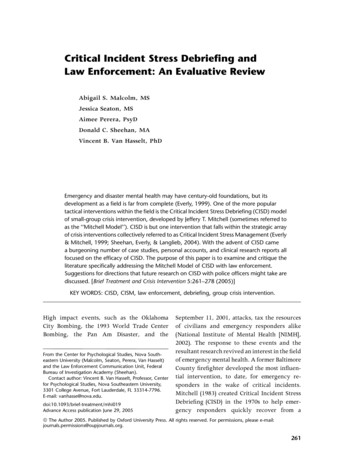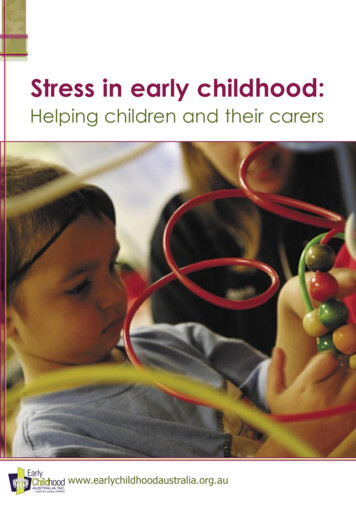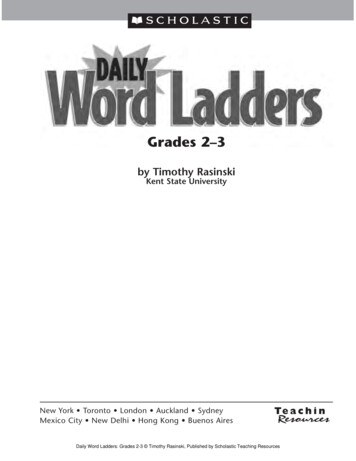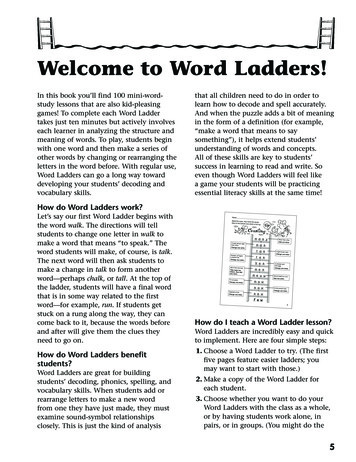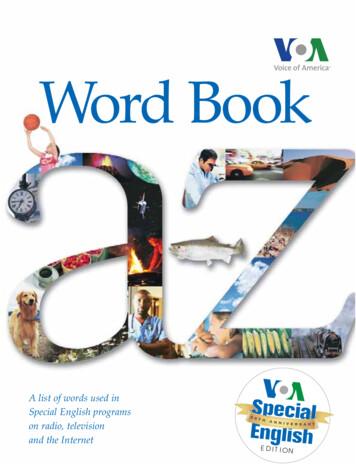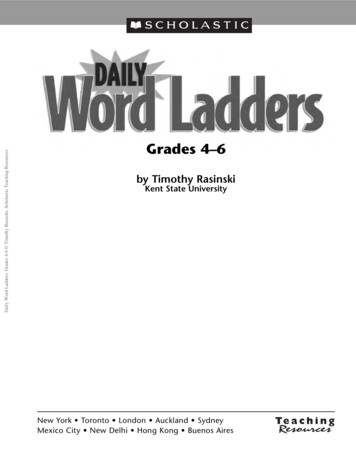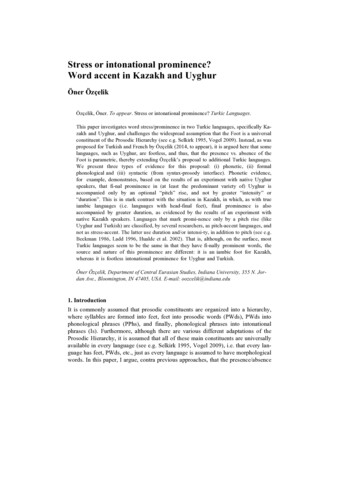
Transcription
Stress or intonational prominence?Word accent in Kazakh and UyghurÖner ÖzçelikÖzçelik, Öner. To appear. Stress or intonational prominence? Turkic Languages.This paper investigates word stress/prominence in two Turkic languages, specifically Kazakh and Uyghur, and challenges the widespread assumption that the Foot is a universalconstituent of the Prosodic Hierarchy (see e.g. Selkirk 1995, Vogel 2009). Instead, as wasproposed for Turkish and French by Özçelik (2014, to appear), it is argued here that somelanguages, such as Uyghur, are footless, and thus, that the presence vs. absence of theFoot is parametric, thereby extending Özçelik’s proposal to additional Turkic languages.We present three types of evidence for this proposal: (i) phonetic, (ii) formalphonological and (iii) syntactic (from syntax-prosody interface). Phonetic evidence,for example, demonstrates, based on the results of an experiment with native Uyghurspeakers, that fi-nal prominence in (at least the predominant variety of) Uyghur isaccompanied only by an optional “pitch” rise, and not by greater “intensity” or“duration”. This is in stark contrast with the situation in Kazakh, in which, as with trueiambic languages (i.e. languages with head-final feet), final prominence is alsoaccompanied by greater duration, as evidenced by the results of an experiment withnative Kazakh speakers. Languages that mark promi-nence only by a pitch rise (likeUyghur and Turkish) are classified, by several researchers, as pitch-accent languages, andnot as stress-accent. The latter use duration and/or intensi-ty, in addition to pitch (see e.g.Beckman 1986, Ladd 1996, Hualde et al. 2002). That is, although, on the surface, mostTurkic languages seem to be the same in that they have fi-nally prominent words, thesource and nature of this prominence are different: it is an iambic foot for Kazakh,whereas it is footless intonational prominence for Uyghur and Turkish.Öner Özçelik, Department of Central Eurasian Studies, Indiana University, 355 N. Jordan Ave., Bloomington, IN 47405, USA. E-mail: oozcelik@indiana.edu1. IntroductionIt is commonly assumed that prosodic constituents are organized into a hierarchy,where syllables are formed into feet, feet into prosodic words (PWds), PWds intophonological phrases (PPhs), and finally, phonological phrases into intonationalphrases (Is). Furthermore, although there are various different adaptations of theProsodic Hierarchy, it is assumed that all of these main constituents are universallyavailable in every language (see e.g. Selkirk 1995, Vogel 2009), i.e. that every language has feet, PWds, etc., just as every language is assumed to have morphologicalwords. In this paper, I argue, contra previous approaches, that the presence/absence
164Öner Özçelikof the Foot is parametric; that is, while some languages, such as English, requireevery prosodic word (PWd) to have at least one foot, other languages, such as Turkish and Uyghur, are footless in the default case, or at least, their grammar does notassign foot structure (although the grammar can keep a foot that was assigned lexically). That Turkish grammar does not, in the usual case, parse syllables into feethas already been proposed in previous research (Özçelik 2014, and was later extended to French (Özçelik, to appear). Whether it is true for additional languages, orwhether this holds true for, for example, all Turkic languages, remains to be investigated, however.The first candidates that come to mind for a footless language are, of course,other Turkic languages, which share many linguistic characteristics with Turkish,and are generally assumed to have similar prosodic properties, e.g. in that prominence falls on the final syllable of words in most Turkic languages (see e.g. Johanson 1998, Schiering & van der Hulst 2010). Furthermore, as Johanson (1998) notes,there is a difference in many Turkic languages in the manifestation of regular finalvs. (exceptional) non-final prominence; whereas final prominence is realized aspitch, non-final stress is dynamic stress-accent (which can also bear pitch), whichcan be taken to imply that final prominence may not involve stress to begin with.This phenomenon is, in fact, one type of evidence, among others, that Özçelik(2014, to appear) presents for the footless status of Turkish (final stress) based onexperimental findings from Konrot (1981) and Levi (2005). The situation in otherTurkic languages could be very similar to that in Turkish, as is predicted by Johanson’s (1998) observations. However, although much research has been done onTurkish stress (see e.g. Johanson & Csató 1998, Hayes 1995, Inkelas 1999, Inkelas& Orgun 1995, 1998, Kaisse 1985, Kabak & Vogel 2001, Lees 1961, Lewis 1967,Özçelik 2014, to appear, Sezer 1983, Underhill 1976, van der Hulst & van de Weijer1991), stress/prominence in other Turkic languages has rarely been studied. And thelittle research that is available does not present any experimental findings, or an indepth discussion of cases that diverge from the norm, such as exceptional stress (seee.g. Alpysbaeva, Ismagulova & Turguzhanova 1995, Балақаев & Исқақов 1954,Баскаков et al. 1966, Batayeva 2013, Кайдаров 1997, Kirchner 1998, Krippes1993, Muhamedowa 2016, Pratten & Omarova 1994, Somfai-Kara 2002 on Kazakh;Comrie 1997, Hahn 1991, Jiang et al. 2010, Liang 2009, Liang & Zhang 2008, 1998,Muti 2007, Yakup 2013 on Uyghur; Johanson 1998 on general Turkic). This paperaims to close this gap, and makes an initial attempt to shed light on the status ofstress/prominence in two Turkic languages: Kazakh and Uyghur. In doing so, asmuch as it answers some previously unanswered questions, it also poses additionalones for future research to address.The assumption that the Foot is a universal constituent of the Prosodic Hierarchyis held despite the fact that even when learning languages with foot structure, children’s initial utterances do not contain any evidence of feet. In fact, children’s initialoutputs are not in the form of (the unmarked) binary feet; they are rather monosyllabic (Jakobson 1941/68), and critically monomoraic, utterances (see e.g. Fikkert
165Word accent in Kazakh and Uyghur1994, Demuth 1995, Goad 1997). These findings do not receive a reasonable explanation under the assumption that the Foot comes as part of the Prosodic Hierarchy,and thus UG, given that children receive positive evidence containing foot structurefrom the beginning of the acquisition process. Thus, if the Foot is universal, it is notclear why children would not produce the unmarked form of prosodic words (PWds)from the very beginning, words composed of binary feet. If, on the other hand, thepresence/absence of the Foot was parametric, and thus the Foot was available onlyin some languages, children could start the language acquisition process with footless utterances, and then add the Foot to their grammar based on positive evidence inlearning a language that has foot structure, such as English. This would solve theproblem posed by child language acquisition research, but would require the existence of footless languages, i.e. languages whose grammar does not assign feet, suchas Turkish (Özçelik 2004, to appear).In this paper, I argue that such languages do exist, and are not limited to Turkish.For example, having both regular and exceptional stress, Uyghur presents formal (aswell as acoustic) evidence of lack of foot structure, both from the PWd-level andfrom facts at the syntax-prosody interface (PPh-level and beyond). In addition toformal evidence, I also present evidence in the form of acoustic correlates of prominence in reporting the findings of an experiment. Kazakh, on the other hand, I argue,differs from both Turkish and Uyghur in that it is a truly iambic language, one inwhich heads of feet are heavier in weight than dependents. Further, I also demonstrate, for Uyghur, that there are three different varieties as far as stress/prominenceis concerned; although the footless Turkish-like variety is the predominant one, it isby no means the only variety, thereby partially accounting for the conflicting proposals raised for Uyghur stress in previous literature.On an account that views the presence/absence of the Foot as parametric, prosodic representations of the world’s languages can be summarized as follows: Whereas(1a) illustrates the internal structure of a PWd for a footed trochaic language likeEnglish, (1b) demonstrates the same thing for the iambic counterpart of footed languages, i.e. languages like Kazakh. Finally, (1c) presents the prosodic representationof words for Uyghur, in which words are footless in the default case. Thus, althoughin both Kazakh and Uyghur (or Turkish), primary prominence falls on the final syllable of prosodic words, being iambic (and thus footed), Kazakh is more like English with respect to having feet than other Turkic languages:(1)a. English:/dʒɛnəsiz/ ‘genesis’b. Kazakh:/købelek/ ‘көбелек’PWdPWdFtFtσ σ σ gé . ne . sisσ σ σkø . be . lékc. Uyghur:/kipinek/ ‘ ’ﻛٮﭙٮﻨەك PWdσ σ σki . pi . nek
166Öner Özçelik(2) below presents the settings of the parameters of prosody that are assumed inorder to reach these assumptions. These will be motivated in the rest of this paper.(2)a. Footednessb. Extrametricalityc. Directionalityd. Foot Binaritye. Headednessf. /AN/A2. “Stress” in Turkic languages: the case of Turkish, Uyghur and Kazakh:2.1. Regular stressIt is commonly assumed that “stress” in Turkic languages falls on the final syllableof prosodic words (see e.g. Johanson 1998, Schiering & van der Hulst 2010).1 (3)below illustrates this for Turkish, the Turkic language whose stress pattern has mostcommonly been investigated (see also Inkelas & Orgun 1998, Kabak & Vogel 2001,Özçelik 2014, Sezer 1983, van der Hulst & van de Weijer 1991).(3)a.kedícat‘cat’b. kedi-lércat-PL‘cats’c. kedi-ler-ímd. my cats’‘on my cats’Uyghur works very similarly to Turkish, as is illustrated in (4) below. As with Turkish, each time a suffix is added, prominence moves to the rightmost syllable, demonstrating that, as with Turkish, prominence is word-final in Uyghur. This is the lineheld by most previous research on Uyghur prominence (e.g. Engesaeth et al. 2009,Jiang et al. 2010, Liang & Zhang 2008, Muti 2007, Yakup 2013).(4)a.müʃúkcat‘cat’b. müʃük-lércat-PL‘cats’c. müʃük-lir-ímcat-PL-POSS1SG‘my cats’d. müʃük-lir-im-décat- PL-POSS1SG-lOC‘on my cats’One widely cited account that differs from mainstream descriptions of Uyghur, andposits Uyghur to be rather different from other Turkic languages is that of Hahn1There are Turkic languages that do not comply with this generalization, such as Chuvash,which is a Default-to-Opposite Edge stress language, in which leftmost light syllable isstressed in words that are composed only of light syllables, and when a heavy syllable isavailable, the rightmost heavy syllable bears stress (Krueger 1961, Dobrovolsky 1999,Gordon 2000).
167Word accent in Kazakh and Uyghur(1991) (see also Comrie 1997, among others), according to which stress is assignedto the last heavy syllable (CVC or CVV) in ultimate or penultimate position (e.g.LLH́ , LHH́ , LH́ L), and if no such syllable exists, then primary stress is assigned tothe final syllable of the word (e.g. LHLĹ, LLĹ, HLLĹ). To date, the differencesbetween the two contrasting descriptions of Uyghur stress have not been addressed.On the surface, Kazakh looks very similar to Turkish and Uyghur, as is illustrated in (5); the only apparent difference in Kazakh is the fact that the final open syllable is lengthened, as illustrated in (5d).(5)a. almá b. alma-lárappleapple-PL‘apple’‘apples’c. alma-lar-ímd. alma-lar-ɨm-dá:apple- PL-POSS1SGapple- PL-POSS1SG-LOC‘my apples’‘in my apples’Closer investigation, however, reveals some interesting differences, all seeminglymotivated by weight and complementing the picture of final lengthening observed in(5) (though see below). Examine the forms in (6).(6)a. kép.ka‘hat’b. ʃe.gírt.ke‘grasshopper’c. der.ba.zá: d. sa.rɨm.sák‘door’‘garlic’These data indicate that, at least in some varieties of Kazakh, syllable weight iscrucial in determining which syllable bears stress within a given word; that is, heavysyllables attract stress, whether they are heavy due to the length of the nucleus vowel (i.e. CVV) or by means of having a coda consonant (i.e. CVC). Although, at afirst look, these forms seem to be exceptional in the same way that Turkish and Uyghur have exceptional (non-final) stress (see (7) and (8)), I will argue in Section 5.2that these are in fact part of the norm in Kazakh, and are thus different from Turkishand Uyghur. This is because weight plays a crucial role in the assignment of stress inthis language, as will be revealed by experimental findings. Before moving on to amore detailed explanation of these forms in Kazakh, we first present a description ofexceptional stress in the three languages.2.2. Exceptional stressWhen stress is non-final in Kazakh, Turkish and Uyghur, it is said to be exceptional.In general, there are two types of exceptional stress in these languages. One involvesroots, and the other, which has been more commonly studied, involves a small set ofsuffixes. These suffixes, when available, cause non-final stress. In general there aretwo types of non-final stress driving suffixes. One involves pre-stressing suffixes,and the other stressed suffixes.
168Öner Özçelik2.2.1. Pre-stressing suffixes(7), (8) and (9) below illustrate pre-stressing suffixes in Turkish, Uyghur and Kazakh respectively. (Pre-stressing suffixes are underlined throughout the paper.) Notice that these suffixes, when available, cause stress to fall on the immediately preceding syllable, irrespective of where in the word they are located.(7)a.dinle-dílisten-PAST‘(He) listened.’b. dinle-dí-milisten-PAST-Q‘Did he listen?’c. dinlé-me-dilisten-NEG-PAST‘He didn’t listen.’(8)a.aŋli-dílisten-PAST‘(He) listened.’b. aŋli-dí-mu?listen-PAST-Q‘Did he listen?’c. aŋlí-mi-dilisten-NEG-PAST‘He didn’t listen.’Note that these suffixes are (almost) always monosyllabic in Turkish and Uyghur,and monosyllabic exceptional suffixes never exceptionally bear stress themselves(i.e. are stressed despite other suffixes/syllables following); they are always prestressing. The two languages do indeed have some suffixes that exceptionally bearstress, but these are always bisyllabic (see section 2.2.2 below).Kazakh is also stated to have exceptional pre-stressing suffixes, most notablypronominal agreement suffixes, examples of which are presented below in (9):(9)a.oqɨtɨwʃı́ -mɨnteacher-COP1SG‘I am a teacher’b. oqɨtɨwʃı́ -ma?teacher-Q‘teacher?’c. We are some/among the teachers’2.2.2. Stressed exceptional suffixesTurkish and Uyghur also have a set of suffixes that are exceptionally stressed, andthese are always bisyllabic. In addition, it is always the initial syllable of a bisyllabicexceptional suffix that is stressed:(10) Turkishgel-íyor-ducome-CONT-PAST‘(X) was coming’(11) Uyghurkel-íwat-iducome-CONT-PRES‘(X) is coming.’
Word accent in Kazakh and Uyghur169Kazakh also has some stressed exceptional suffixes, but unlike Turkish and Uyghur,these can also be monosyllabic, such as the present suffix, which gets stressed,whether or not it is followed by a person agreement suffix, as is exemplified in (12).(12)Kazakha. ket-é-siŋleave-PRES-COP2SG‘You (will) leave.’b. bar-á-dɨgo-PRES-COP3SG‘He goes/will go.’3. Current accountThis paper proposes a unified account of regular and exceptional stress in the twoTurkic languages of Uyghur and Kazakh. The analysis for Kazakh is the simpler oneand is very straightforward from the perspective of phonological theory: It is a typical iambic language, which is weight-sensitive, as is true for iambic languages ingeneral, which are arguably always weight-sensitive (see e.g. McCarthy & Prince1986, 1993, Hayes 1991, 1995, but cf. Altshuler 2009). Final stress in Kazakh wordswould then be ensured through Right-to-Left footing, meaning that a single weightsensitive iambic foot is built at the right edge of a word, leading to word-final stress,e.g. [LL(LH́ )].The analysis for Uyghur is very different; though with its regular word-finalprominence, it looks very similar to Kazakh. In Uyghur, we have noticed three different patterns of stress, depending on the speaker, all essentially different fromKazakh. In the most predominant pattern, as opposed to Kazakh, regular word-final“stress” is best analyzed not as stress, but as intonational prominence falling on thefinal syllable of prosodic words; i.e. it does not involve foot structure. Exceptionalstress, however, does involve foot structure in Uyghur, and is trochaic. The idea hereis very similar to that of Özçelik (2014, to appear). As with Turkish, the grammar ofthe predominant variety of Uyghur (according to our data) does not assign footstructure at all, but if certain morphemes (i.e. exceptional stress driving suffixes) arealready footed in their underlying representation/lexicon, then they will be footed inthe surface representation too (i.e. the output of the grammar in Optimality Theoreticterminology). In this proposal, the whole grammar is trochaic; it is just that Trochaicity is vacuously satisfied for words that do not have any feet at all (regularlystressed words), since there are no feet in these words to begin with. In sum, Turkish/Uyghur and Kazakh are very different under this proposal, with the former twobeing trochaic languages and the final one, Kazakh, iambic.The prosodic grammars of the two types of Turkic languages are presented in theform of an OT style constraint ranking in (13) and (14) below.
170Öner Özçelik(13) Kazakh: iambic with weight sensitivityIAMBIC, FT-BIN WSP2 TROCHAIC(14) Uyghur and Turkish: trochaic with no weight sensitivityTROCHAIC, FT-BIN FINAL-PROMINENCE IAMBICThat is, Kazakh is a typical iambic language on this proposal, as is also illustrated inthe following OT *!**!**Turkish and Uyghur, on the other hand, are both trochaic. The question that arisesthen is how a trochaic language receives prominence on the final syllable in theusual case (i.e. the so-called regularly stressed words). This is because regular“stress” in these two languages is not stress but is instead intonational prominence,and, as such, is not assigned through feet, but rather via an independent constraintFINAL-PROMINENCE, which places intonational prominence on the final syllable ofPWds in the absence of foot structure. This is illustrated in (16) below for Uyghur(the predominant ght-to-Stress Principle (WSP) dictates (i) that stressed syllables are heavy, and (ii)that unstressed syllables are light, although not all linguists argue for both of the conditions, and there are variations in the literature (see e.g. Prokosch (1939), Chomsky & Halle (1968), Hayes (1981), Halle & Vergnaud (1987), Kager (1989), Prince (1990), Prince& Smolensky (1993), Burzio (1994), and Hammond (1999).
171Word accent in Kazakh and UyghurThat is, although the language is trochaic, trochaicity does not become obvious unless one of the exceptional stress driving suffixes are available, as the language cannot assign foot structure to begin with.When an exceptional suffix is available, however, things are a little different, because these suffixes already come footed in their UR, and given certain prosodicfaithfulness constraints, they are footed in the SR, too. So we will need to update ourconstraint ranking presented above in (14) as follows.(17) TROCHAIC, FT-BIN ANCHOR-RIGHT ANCHOR-LEFT, FINAL-PROMINENCE IAMBICThe Anchor constraints here basically ensure that whatever is footed in the input/URis footed in the output of the grammar/SR. To be more specific, ANCHOR-RIGHTensures that a foot edge that is at the right edge of a syllable in the input shouldsurface at the right edge in the output. ANCHOR-LEFT is its left counterpart; that is,material that is at the left edge in the input should surface at the left edge in the output. Of course, all this assumes inputs that are already footed in the lexicon, in thesense of Özçelik (2014), as illustrated below for Uyghur for monosyllabic and bisyllabic exceptionally stressed suffixes respectively.(18)a. Inputs (URs) for pre-stressing suffixes:(mi)FtNEGbInputs (URs) for stressed suffixes:(iwat)FtPRES-CONTThe fact that ANCHOR-RIGHT and Ft-BIN both rank above ANCHOR-LEFT ensure further that monosyllabic exceptional suffixes, such as (18a), surface as prestressing, i.e. not stressed, nor post-stressing, as illustrated in (19) below.(19) Monosyllabic exceptional suffixes: *!*!*!*!***
172Öner ÖzçelikHere, since the suffix is monosyllabic, there is a violation of one of the Anchor constraints (i.e. ANCHOR-LEFT), so that a higher-ranking constraint, Ft-BIN, is satisfied.If both ANCHOR constraints were satisfied, as in (19a), it would lead to a violation ofFT-BIN, as the foot would no longer be binary.Indeed, for bisyllabic exceptional suffixes, we see a violation of neither constraint, as they are bisyllabic, and therefore keeping the underlying foot edges asthey are will not incur a violation of FT-BIN, which is the reason why monosyllabicexceptional suffixes surface as pre-stressing (not ever stressed), whereas bisyllabicexceptional suffixes are stressed on their initial syllable. Examine (20).(20) Bisyllabic exceptional suffixes: stressed on the first tidú]*!*4. Experimental and acoustic evidenceThe hypothesis put forward above rests on the premise that whereas Kazakh is atruly iambic language, both Turkish and Uyghur are footless. If this proposal, forwhich we presented formal evidence above, is correct, one type of empirical evidence would be supplied by acoustics. While iambic languages tend to be uneven inthat the head of a foot is heavier than the dependent, which usually surfaces in theform of greater duration for stressed syllables (e.g. Bolton 1894, Woodrow1909/1951, Hayes 1991, 1995), neither duration nor intensity are correlates of prominence in languages without stress; prominence in these languages is cued only byan F0 rise at the most (see e.g. Beckman 1986, Ladd 1996, Hualde et al. 2002). Languages without stress are, in turn, good candidates for being footless (Özçelik 2014,to appear).Findings of previous research already offer some insight into the issue, althoughexclusively from Turkish. It has been found that whereas the correlates of Turkishexceptional stress include both significantly greater intensity and F0 rise on thestressed syllable, final prominence is accompanied only by an optional slight rise inF0 (see e.g. Konrot 1981, 1987, Levi 2005, Pycha 2006; see also Kamali 2011,2014, Güneş 2015, and Ipek 2015 for work that not only provides additional evidence for these findings, but also takes into account the effect of prosodic constituency on prominence as well as the effect of speech acts on intonational tunes; seealso Özçelik (2014, to appear) for an interpretation of these facts (along with otherevidence) as indicative of lack of foot structure for Turkish. Since the Turkish factsare better established, we will focus on a comparison between Kazakh and Uyghurin the remainder of this paper. The hypotheses are (i) that stressed syllables shouldbe longer than unstressed syllables in Kazakh, potentially also accompanied by
Word accent in Kazakh and Uyghur173greater intensity, and (ii) that no such pattern should be observed in Uyghur, i.e. thatstressed syllables should be of equal duration and intensity as unstressed syllables.In order to test these hypotheses, as well as to draw a general picture of stress/prominence in Kazakh and Uyghur, we conducted two experiments, one in Kazakhand the other in Uyghur, focusing on words with regular stress/prominence for thepurpose of this study.34.1. SubjectsA semi-controlled production experiment was conducted with seven Kazakh andeight Uyghur native speakers. As was determined by a background questionnaireand a read-aloud task in Russian (for the Kazakh speakers), Chinese (for the Uyghurspeakers), and English (for both, as the subjects were located in the USA), thesespeakers were near-monolingual; although Kazakh or Uyghur was their first language, they also had some non-native knowledge of English in addition to Russianor Chinese. The subjects ranged in age from 25 to 47. All of them lived in the USA,but regularly continued to speak their native language every day. Finally, all of themhad at least college education, or, at the time of testing, were attending college oruniversity.4.2. StimuliThe task involved responding to stimuli of various syllable structure profiles. Therewas a total of 70 words, all of which were common nouns. 20 of these were bisyllabic, comprised of all possible combinations of open vs. closed syllables (i.e. fiveunder each condition, see below), and 40 were trisyllabic, again equally distributedamong all possible combinations of open and closed syllables. The remaining 10were four- and five-syllable words, composed of various different syllable structureprofiles.Tables 1 and 2 below present an example of each condition with bisyllabic andtrisyllabic stimuli in Uyghur and Kazakh respectively. L represents a light/opensyllable, whereas H represents a heavy syllable (although, strictly speaking, thesewere not necessarily heavy, but rather closed). These, along with the rest of thestimuli, were all regularly stressed.3The prediction is that exceptional stress should behave differently regarding acousticcorrelates. In this paper, we focused on regular stress, but findings of research on exceptional stress in languages like Turkish (see above) confirm this prediction, as do some preliminary findings on Uyghur exceptional stress (see below).
174Öner ÖzçelikTable 1. Uyghur stimuliBisyllabic ow ﭘﺎﻗﺎ ﺳﯘﭘﯘن ﺋﺎﻟﻤﺎ ﯾﺎﺳﺘﯘق Trisyllabic teraser ﭼﯜﻣﯜﻟە ﻛېﭙٮﻨەك ﭼېﻜەﺗﻜە ﻛﯚزەﯾﻨەك ﺗﺎﺷﭙﺎﻗﺎ زەﻧﺠٮﯟٮﻞ ﺧٮﺰﻣەﺗﭽﻰ ﺋﯚﭼﯜرﮔﯜچ ктерmenTable 2. Kazakh stimuliBisyllabic малмадəптерTrisyllabic 3. Task and procedureSubjects were placed in an experimental condition where they saw pictures of eachstimulus. They had to utter the name of each stimulus first in isolation and then onceagain in a carrier sentence. The carrier sentences used for Uyghur and Kazakh arepresented in (21) and (22) below respectively.(21). ﺑﯘ رەﺳٮﻤﺪە ﺑٮﺮ ﺑﺎر ‘There is X(22)in this picture.’Бұл суретте бар.‘There is X in this picture.’The stimuli were presented in three steps: First, the subjects had to guess the nameof the pictured item, whose first letter was provided in order to make this task easier.At the second step, they had to utter the stimulus again. And at the third and finalstep, they finally produced the name of the item in a carrier sentence. Only the stimuli in the carrier sentence were transcribed and analyzed for acoustic measures.
Word accent in Kazakh and Uyghur175The steps of the experimental procedure are exemplified below in (23) for Uyghur and Kazakh.(23) Uyghur and Kazakh; experimental steps:Step 1: guess the name of the pictured stimulus and utter it in isolationStep 2: Utter the stimulus again in isolationStep 3: Utter the stimulus in a carrier sentence ((21) for Uyghur; (22) for Kazakh)The reason for not analyzing the words uttered in isolation was to prevent potentialconfounding variables such as utterance-final lengthening and phrase-level accent,both factors that tend to happen utterance-finally (Gordon 2014; Hyman 2014).Each subject was tested individually and in a sound-attenuated booth. They wereaudio-recorded using Audacity (http://audacity.sourceforge.net) onto a Mac computer, with the help of an external Sony microphone, which was placed approximately20 cm from the speakers’ lips. The tasks were administered in the following order: abackground questionnaire, production experiment, and the read-aloud tasks (in English and Chinese and/or Russian). The entire procedure took about one hour persubject.4.4. AnalysisThe responses were transcribed and annotated for placement of stress/prominenceusing Praat acoustic analysis software (Boersma & Weenink 2013). For each experimental word, vowel and syllable duration (in ms), average and peak intensity (indB), average fundamental frequency (F0, in Hz), and time of F0 peak were measured. In addition, the first and second formant frequencies (F1 and F2, in Hz) werenoted with the aim of mapping the subjects’ vowel space, because certain vowels(e.g. high vowels) inherently have lower duration than others (e.g. low vowels)(Fonagy 1966, Beckman 1988). Finally, sentences in which there was a pause between the syllables of the experimental word were excluded from the analysis.Although all the words were analyzed for stress placement in order to get a general picture of stress/prominence in both languages, the acoustic analysis here focused on bisyllabic stimuli composed of two
son 1998, Schiering & van der Hulst 2010). Furthermore, as Johanson (1998) notes, there is a difference in many Turkic languages in the manifestation of regular final vs. (exceptional) non-final prominence; whereas final prominence is realized as pitch, non-final stress is
